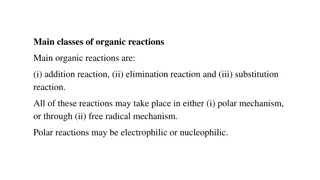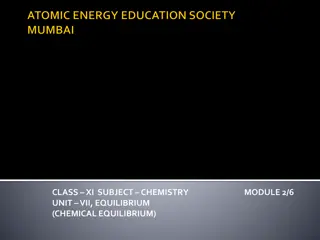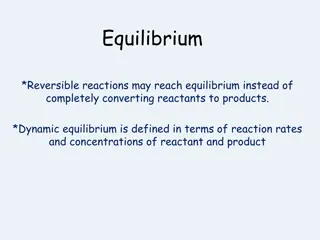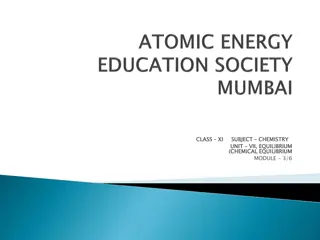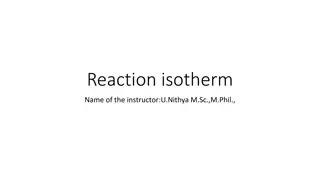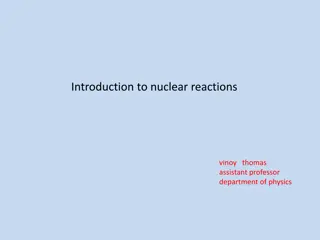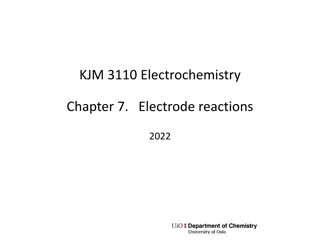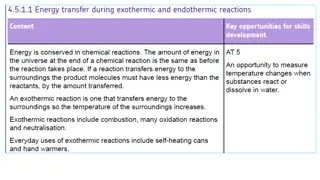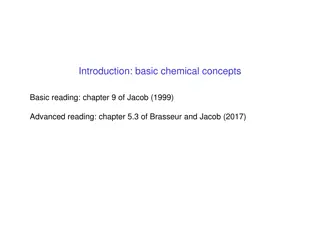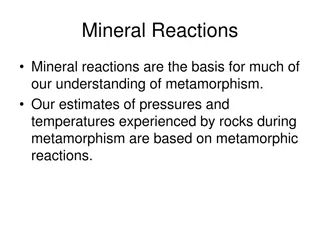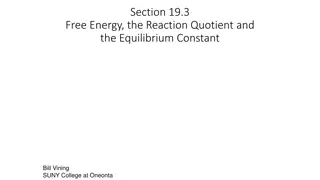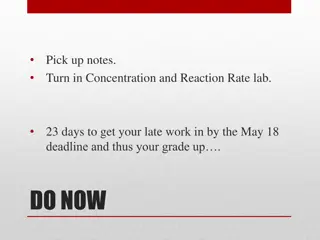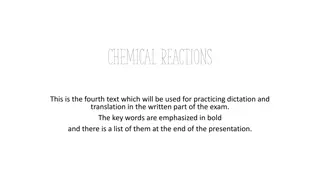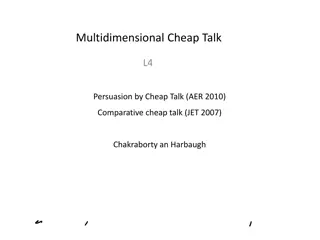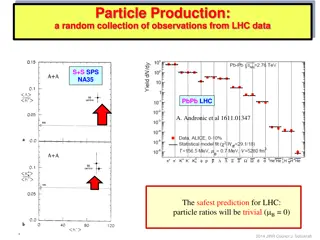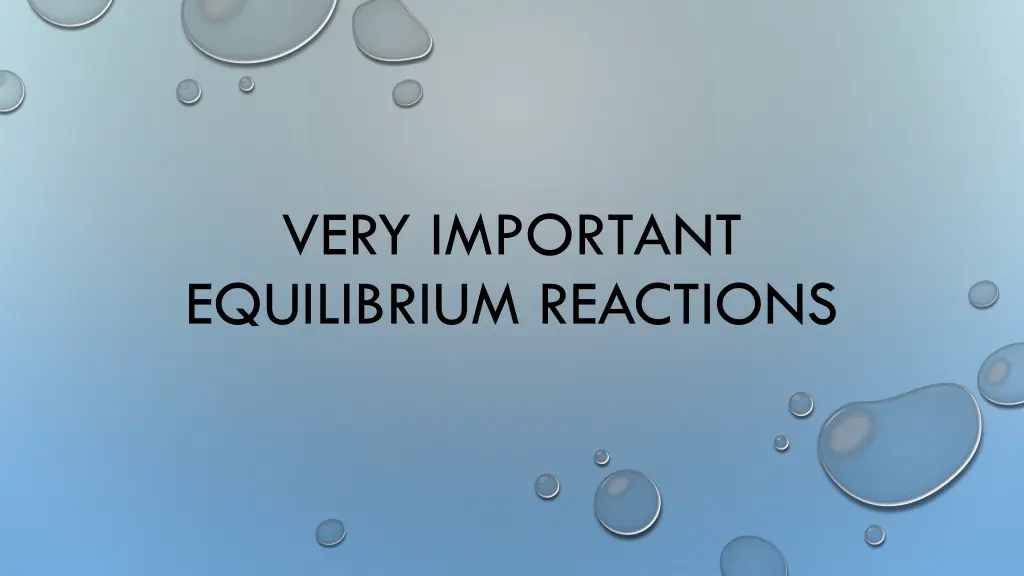
Understanding Equilibrium Reactions in Chemical Processes
Explore the concept of equilibrium in chemical reactions, focusing on key processes like the Haber Process for manufacturing ammonia. Learn about the importance of catalysts, pressure, and temperature in achieving optimal results. Discover the crucial factors that drive these equilibrium reactions and their impact on creating new compounds.
Download Presentation

Please find below an Image/Link to download the presentation.
The content on the website is provided AS IS for your information and personal use only. It may not be sold, licensed, or shared on other websites without obtaining consent from the author. If you encounter any issues during the download, it is possible that the publisher has removed the file from their server.
You are allowed to download the files provided on this website for personal or commercial use, subject to the condition that they are used lawfully. All files are the property of their respective owners.
The content on the website is provided AS IS for your information and personal use only. It may not be sold, licensed, or shared on other websites without obtaining consent from the author.
E N D
Presentation Transcript
VERY IMPORTANT EQUILIBRIUM REACTIONS
EQUILIBRIUM: INTRODUCTION Equilibrium is defined as follows: A state in which opposing forces or actions are balanced so that one is not stronger or greater than the other (Merriam-Webster) Equilibrium in chemical reactions is an important tool in creating new compounds There are many types of equilibrium reactions that have evolved over time Two of the most important equilibrium processes involve the following: The manufacture of ammonia, known as the Haber Process The manufacture of sulfuric acid, known as the Contact Process The properties of both types of processes will be explored in greater detail
EQUILIBRIUM: HABER PROCESS The Haber Process involves the manufacture of ammonia from two gases: Nitrogen (N) and Hydrogen (H) The process flow for this reaction is as follows (Clark, 2002): This flow supports the conversion of N and C under specific conditions to create liquid ammonia (Clark, 2002)
EQUILIBRIUM: HABER PROCESS The Haber Process involves several key components: The catalyst: a combination that includes iron and potassium hydroxide (Clark, 2002) The pressure: pressure is extremely high to generate the gaseous reaction (Clark, 2002) Recycling: Approximately 15 percent of these gases are actually converted to ammonia and the remainder is recycled for future use (Clark, 2002) The gaseous conversion rate for this reaction is approximately 98 percent (Clark, 2002)
EQUILIBRIUM: HABER PROCESS The ratio of Nitrogen to Hydrogen is 1:3, using Avogadro s Law (Clark, 2002) The temperature is lowered to achieve the desired exothermic reaction (Clark, 2002): A lower temperature results in a slower reaction, so 400-450 C is the optimal temperature that manufacturers use to generate the proper reaction (Clark, 2002) The desired level of pressure for this reaction as at least 200 atmospheres to achieve the desired equilibrium (Clark, 2002) This rate reduces manufacturing costs because higher pressures are more expensive to produce (Clark, 2002) Once the reaction is complete, the ammonia converts to liquid and the hydrogen and nitrogen may be reused (Clark, 2002)
EQUILIBRIUM: HABER PROCESS The Haber manufacturing process is described as follows (Rae-Dupree, 2011): This process summarizes the actions taking place to achieve equilibrium and to produce ammonia under ideal conditions
EQUILIBRIUM: CONTACT PROCESS The Contact Process involves the manufacture of sulfuric acid from Sulfur (S) and Oxygen (O) (Clark, 2002) The proposed flow for this reaction is as follows: This reaction flow is designed to transform sulfur dioxide to sulfur trioxide using the following exothermic formula: Once the sulfur trioxide is created, it is dissolved in sulfuric acid, a process known as oleum (Clark, 2002) This product then reacts with H2O to create sulfuric acid in a concentrated form:
EQUILIBRIUM: CONTACT PROCESS Sulfur dioxide and Oxygen must be equally proportioned in order for the proper reaction to occur, according to Avogadro s Law (Clark, 2002) Le Chatelier s Principle supports the belief that increasing oxygen by shifting the equilibrium to the right is a less expensive means of creating sulfuric acid (Clark, 2002) A 1:1 proportion is ideal to reduce sulfur dioxide concentrations (Clark, 2002) The appropriate temperature to achieve the desired reaction quickly is 400-450 C (Clark, 2002)
EQUILIBRIUM: CONTACT PROCESS Higher pressure to produce sulfur dioxide is not worth the risk or the expense (Clark, 2002) Lower pressure has a 99.5% success rate of conversion to produce sulfur dioxide (Clark, 2002) A catalyst has little impact on the reaction other than to increase its speed (Clark, 2002) If a catalyst is not present, the reaction time is very slow, so it is essential to increase the speed of the reaction and to allow the gases to achieve equilibrium (Clark, 2002)
EQUILIBRIUM: CONTACT PROCESS The Contact manufacturing process is described as follows (Wong, 2012): This process summarizes the actions taking place to achieve equilibrium and to produce sulfuric acid under ideal conditions
EQUILIBRIUM: CONCLUSION Achieving equilibrium requires specific reactions to produce the desired chemical compounds The production of ammonia and sulfuric acid are achieved through very specific reactions that involve a number of factors: Temperature Pressure Recycling, in the case of ammonia production These reactions are produced in manufacturing plants under controlled conditions to produce high amounts of product in a cost effective manner
EQUILIBRIUM: REFERENCES Clark, J. (2002). The Contact Process. Retrieved from http://www.chemguide.co.uk/physical/equilibria/contact.html Clark, J. (2002). The Haber Process. Retrieved from http://www.chemguide.co.uk/physical/equilibria/haber.html Merriam-Webster (2013). Equilibrium. Retrieved from http://www.merriam-webster.com/dictionary/equilibrium Rae-Dupree, J. (2011). Phrase of the week: Haber-Bosch Process. Retrieved from https://news.slac.stanford.edu/features/phrase-week-haber-bosch-process Wong, S. (2012). Properties of sulfur. Retrieved from http://igcsetuition.blogspot.com/2012/12/sulfur_9.html



